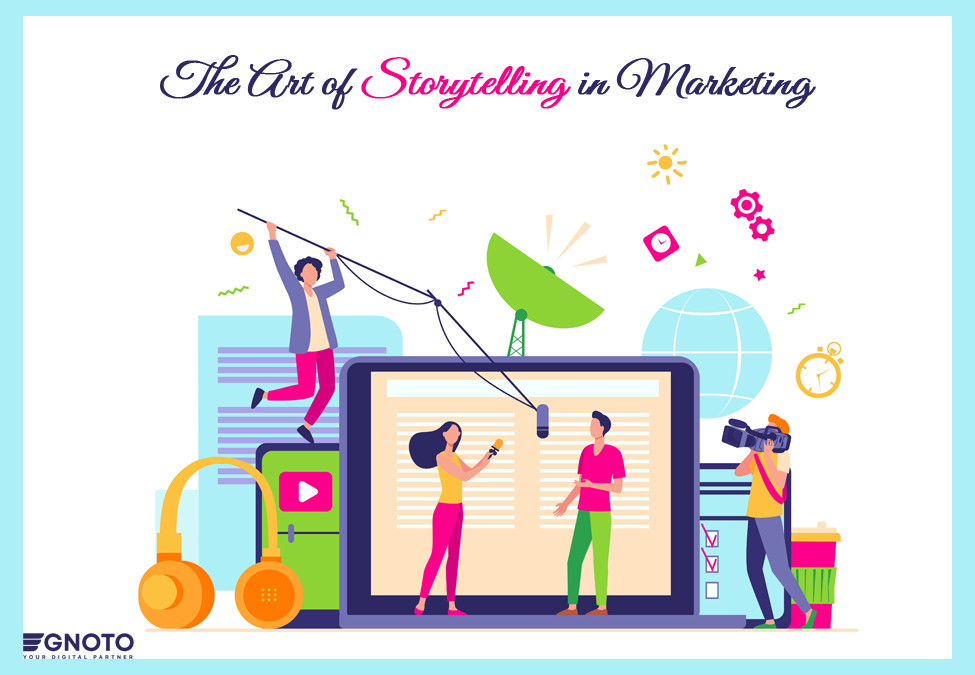According to Harvard Business Review, companies that tap into customers’ emotions can reap significant rewards. We all know that humans are emotional beings. When they connect with things that remind them of a particular emotion, it affects their decisions.
Do you remember Nike’s “You Can’t Stop Us” campaign? It featured a split-screen video showcasing athletes’ determination during the pandemic. The video evoked emotions like hope, determination, and unity. This campaign significantly increased sales and brand perception.
You can also use the power of storytelling to boost your company’s sales. However, it is not like merely telling a story without any aim. You have to focus on many things to use the power of a good story correctly in content marketing.
Explore this blog from top to bottom and find solutions to all your questions, like how storytelling drives engagement, why emotional connections matter, how you can leverage AI to create a powerful narrative, and much more.
What Is Storytelling in Content Marketing?
Storytelling is the art of using compelling narratives to promote a brand, product, or service in marketing campaigns. It engages audiences emotionally to make the message more relatable and memorable.
You do not focus on sales pitching while using storytelling; instead, you highlight experiences, values, and connections that resonate with the target audience. You can establish a strong relationship with buyers, which will benefit you in the long run because people are connected with you emotionally.
How Stories Affect the Brain?
Stories are everywhere; they surround us in various ways. Understanding the science behind it will help you use this marketing strategy effectively.
Stories are an effective way to transmit information and values from one individual to others. They can be transmitted as texts, videos, or images. Our brains starve for attention, so whenever people see engaging content, comments, videos, or taglines, they are attracted to them. The same concept is used in movies, TV shows, and books: “The Hook.” By reading a story, people can reach any world mentally.
The emotional connection helps audiences:
- To relate
- To-retain
- To act
Why Use Storytelling in Content Marketing?
Coming back to the content marketing. Since human brains love good stories, you can use narratives to influence their buying decisions. Let’s understand how storytelling proves beneficial for marketers and companies.
1. Creates Emotional Connection:
Stories evoke emotions that help customers feel more connected to the brand. Customers start considering a brand like a person who gets hurt, thinks, laughs, and becomes sad. It makes them more likely to engage and buy products from the company.
For example, a brand can share a story of overcoming challenges and becoming a big name in the industry. This makes people feel that companies also face problems like humans. This emotional connection creates trust and a high level of engagement between a brand and a customer.
2. Increases Brand Recall:
How do you remember the brand Zara? When you read or hear this name, an image of a sportsperson wearing Zara shoes comes to mind. The brand evokes emotions like leadership and pride. So, you often remember the brand through the stories they tell in their marketing campaigns.
An emotional response to an ad has a far greater impact on consumers’ intent to purchase than the ad’s content alone. Here is a list of some emotions that brands once used in their content marketing
- Happiness: Brands like Disney and Coca-Cola tap into happiness.
- Fear: Allstate and Vodafone used fear as a way to make their message memorable.
- Trust: Johnson and Johnson is an example of a brand that uses trust.
- Pride: Nike and BMW use pride as an emotional hook.
- Leadership: Tesla and Amazon evoke a sense of leadership.
3. Enhances Customer Engagement:
In content marketing, customer engagement is vital as it increases the chances of more sales. Storytelling helps drive engagement because people feel more connected to stories. It makes brands more relatable to customers. They often share their experiences with the brand after buying a product.
Narratives used in marketing on different platforms like websites, social media, YouTube, and print media can boost conversion by 30% So, storytelling has changed the game in content marketing. It also helps in customer acquisition and retention because it builds trust and encourages long-term loyalty.
4. Improves Credibility:
Storytelling improves credibility by humanizing the brand and making it more relatable. Real customer stories evoke trust in customers, which is helpful to look at the brand as a reliable source of buying a product or service.
More than 60% of consumers decide to buy after watching a brand video because it evokes trust. An easy and effective narrative clearly shows the brand’s value to the audience, improving reliance on the brand.
5. Drives Action:
Storytelling drives action because when you emotionally connect with a brand, you trust it more, which drives you to buy from it. A well-told story can drive conversions and increase a company’s profit.
This is why 62% of marketers leverage storytelling in content marketing. Moreover, 68% of people acknowledge that brand stories influence purchasing decisions.
Types of Storytelling in Content Marketing
If you are also planning to use storytelling in your content marketing campaigns, understanding types of storytelling will help you immensely. You can choose the right type for your content type.
1. Brand Stories:
Brand stories tell a company’s mission, values, and vision and provide a glimpse into its history, purpose, and struggle. For example, Nike communicates its brand story by showing images and videos of professional athletes. Apple, Amazon, Zara, and many other brands also create brand stories. Once the brand story is presented to the audience, it can’t be changed.
2. Product Stories:
These days, simply showing a product image and writing its description doesn’t bring sales. Instead, show people how the product solves a consumer’s problem.
A product story can use information like
- Creation of the product
- A customer story
- Changes in the product features
- And more
3. Social Impact Stories:
This type of storytelling shows the brand’s commitment to social responsibilities. Since people have become aware of their social responsibilities towards animals and the environment, they like to buy from a brand that also cares about the environment and animals.
This type of story creates emotions like compassion, empathy, and responsibility. It positively impacts the brand’s image and promotes loyalty. For example, Tom Shoes uses social impact stories. Their one-for-one campaign highlights their commitment to helping needy people.
4. Customer Stories:
User-generated content tells stories of how people buy, use, and experience the product. When people see how others benefit from the product, they also feel like buying it. People trust peers more than a brand. They want to know whether existing customers have had a good experience with the company.
Airbnb uses this type of storytelling to show how it connects travelers with locals. If people enjoy connecting with people who share new cultures and experiences, this type of marketing strategy is effective in attracting them.
How to Use Storytelling in Marketing? Dos and Dont’s
Storytelling can make or break your brand because it has the power to create an emotional connection with people. If you use storytelling incorrectly, it can also ruin your efforts and brand image. Focus on what to do and what not to do while using storytelling.
| Do’s of Storytelling | Dont’s of Storytelling |
| Tailor the story to resonate with your audience | Keep the story simple and clear |
| Ensure your story reflects the brand’s value | Misalign the story with the brand’s message. |
| Use a clear beginning, middle, and end. | Using too much jargon or technical language |
| Use impactful images. | Too much reliance on text and visuals. |
How to Leverage AI for Storytelling?
Nowadays, you will not have to think of stories and work on their aspects manually. AI tools have made many tasks of using stories in content marketing easy. We have explained below how you can use AI for storytelling and save time and resources.
1. Generate Story Ideas:
The story idea is the first thing you begin with. With the help of generative AI like Gemini, ChatGPT, and other tools, you can generate an effective idea for a story. But before this step, decide on platforms where you will use this story idea because it helps to create content that fits the interests of the audience.
For example, Instagram audiences like images and short videos. So, think of a story that fits this type of content.
2. Automate Content Creation:
You can not only use generative AI tools to generate story ideas but also generate an entire story. Since AI is still in the process of humanizing content, you must read the story and modify it accordingly.
Example of a prompt for a product story:
Create a short story about a busy professional who tries a productivity tool and discovers how it transforms their daily routine. End with a testimonial on how it improves work-life balance.
You can modify the prompt according to the type of result you want from the tool.
3. Personalize Content:
AI can tailor content according to the audiences and their interests. Many AI-powered CRM tools store customers’ information and help write personalized emails. Around 6% of marketers use AI for personalized marketing to filter various things and narrow their approach. Moreover, with AI-driven tools, you can predict customer behavior, recommend products, and craft content that resonates with your audiences.
4. Improve and Edit:
There is fierce competition in content marketing. If you follow traditional methods, it can take more time than your competitors. With the help of AI, you can take some of the work off. Buffer’s AI assistant tool helps marketers rephrase, shorten, expand, and do much more with content. Moreover, tools like Grammarly help to highlight grammar mistakes and recommend the most suitable words.
5. Generate Visuals:
Visuals have become a crucial part of content for online marketing campaigns. Whether marketing on social media, TV, or print media, visuals always stand out. Tools like Canva, Adobe, Runway ML, and others use AI to generate and edit exquisite images and videos.
Bottom Line
Creative and engaging content brings positive results. Stories play a crucial role in creating this type of content. They attract audiences and make them feel like they are interacting with a person, not a business. Well-thought stories create an emotional connection, improve brand image, drive actions, and do much more for a company. You can use stories to enhance brand image, launch a new product, and tell customer experiences. Moreover, leverage the power of AI technology to improve and speed up the process of creating an engaging story and using it for marketing.










